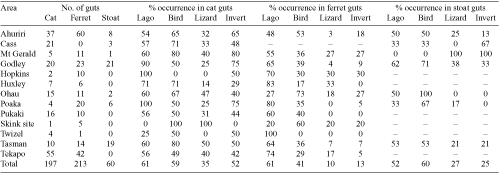Diet of mammalian predators in braided river beds in the central South Island, New Zealand
Elaine C. Murphy A D , Rachel J. Keedwell B , Kerry P. Brown C and Ian Westbrooke AA Department of Conservation, PO Box 13 049, Christchurch, New Zealand.
B 24 Buick Crescent, Palmerston North, New Zealand.
C Department of Conservation, PO Box 5086, Wellington, New Zealand.
D Corresponding author. Email: emurphy@doc.govt.nz
Wildlife Research 31(6) 631-638 https://doi.org/10.1071/WR03033
Submitted: 28 April 2003 Accepted: 16 August 2004 Published: 23 December 2004
Abstract
In New Zealand, five of the six endemic bird species that breed primarily in South Island braided river beds are classed as threatened. A major cause of decline for these species is predation by introduced mammals, and predator-trapping programs are undertaken in the braided rivers of the Mackenzie Basin to protect them. Trapping programs carried out between September 1997 and April 2001 provided the opportunity to investigate predator diet from the gut contents of 375 cats (Felis catus), 371 ferrets (Mustela furo) and 86 stoats (Mustela erminea). As a percentage frequency of occurrence of the main prey items, cat diet consisted of lagomorphs (present in 70% of guts), birds (in 47%), lizards (30%) and invertebrates (36%). Ferret diet consisted of lagomorphs (69%) and birds (28%). Stoat diet consisted of lagomorphs (50%), birds (51%), lizards (21%) and invertebrates (23%). The frequency of occurrence of birds in all three predators was higher in the spring/summer of 1997 – immediately after rabbit haemorrhagic disease (RHD) was introduced – than in any other previous diet study on these braided rivers. This suggests that RHD did lead to increased predation pressure on birds, at least in the short term.
Acknowledgments
We thank all the people who helped in the predator-trapping program in 1997/98, and thanks in particular to Peter Cook and the kaki team for providing predator guts from the kaki-trapping program 1998–2000. We offer thanks to all the landholders who cooperated with the trapping program, and the Department of Conservation staff of the Twizel Area and Canterbury Conservancy Offices. Thanks also to Chris Morse and Fraser Maddigan, who helped with some of the diet analyses. John Dowding, Michael Ryan and two referees made useful comments on earlier versions of this manuscript.
Alterio, N. , and Moller, H. (1997). Diet of feral house cats Felis catus, ferrets Mustela furo and stoats M. erminea in grassland surrounding yellow-eyed penguin Megadyptes antipodes breeding areas, South Island, New Zealand. Journal of Zoology 243, 869–877.
Catling, P. C. (1988). Similarities and contrasts in the diets of foxes, Vulpes vulpes, and cats, Felis catus, relative to fluctuating prey populations and drought. Australian Wildlife Research 15, 307–317.
Courchamp, F. , Langlais, M. , and Sugihara, G. (1999). Control of rabbits to protect island birds from cat predation. Biological Conservation 89, 219–225.
| Crossref | GoogleScholarGoogle Scholar |
Dowding, J. E. , and Murphy, E. C. (2001). The impact of predation by introduced mammals on endemic shorebirds in New Zealand: a conservation perspective. Biological Conservation 99, 47–64.
| Crossref | GoogleScholarGoogle Scholar |
Holden, C. , and Mutze, G. (2002). Impact of rabbit haemorrhagic disease on introduced predators in the Flinders Ranges, South Australia. Wildlife Research 29, 612–626.
Keedwell, R. J. , and Brown, K. P. (2001). Relative abundance of mammalian predators in the upper Waitaki Basin, South Island, New Zealand. New Zealand Journal of Zoology 28, 31–38.
McDonald, R. A. , Webbon, C. , and Harris, S. (2000). The diet of stoats (Mustela erminea) and weasels (Mustela nivalis) in Great Britain. Journal of Zoology 252, 363–371.
| Crossref | GoogleScholarGoogle Scholar |
Norbury, G. (2001). Conserving dryland lizards by reducing predator-mediated apparent competition and direct competition with introduced rabbits. Journal of Applied Ecology 38, 1350–1361.
| Crossref | GoogleScholarGoogle Scholar |
Norbury, G. , Heyward, R. , and Parkes, J. (2002). Short-term ecological effects of rabbit haemorrhagic disease in the short-tussock grasslands of the South Island, New Zealand. Wildlife Research 29, 599–604.
Pierce, R. J. , and Maloney, R. F. (1989). Responses of harriers in the Mackenzie Basin to the abundance of rabbits. Notornis 36, 1–12.
Sanders, M. D. , and Maloney, R. F. (2002). Causes of mortality at nests of ground-nesting birds in the Upper Waitaki Basin, South Island, New Zealand: a 5-year video study. Biological Conservation 106, 225–236.
| Crossref | GoogleScholarGoogle Scholar |

|


